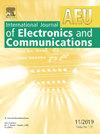Sub-threshold 10 T FinFET-based single-ended SRAM cell for energy-efficient high-speed operation
IF 3.2
3区 计算机科学
Q2 ENGINEERING, ELECTRICAL & ELECTRONIC
Aeu-International Journal of Electronics and Communications
Pub Date : 2025-09-19
DOI:10.1016/j.aeue.2025.156046
引用次数: 0
Abstract
An ultra-low-power, high-speed 10-transistor (P10T) sub-threshold Static Random-Access Memory (SRAM) bit-cell featuring single-ended operation has been proposed and evaluated in this work. To enhance read stability and minimize read delay, a decoupled read path comprising an inverter and a low threshold voltage transistor has been employed. Furthermore, writability and write delay have been improved by integrating a power gating mechanism in the write path. The bit-cell design also benefits from reduced leakage power, which is attributed to the elimination of bitline leakage during read operations and the stacked transistors availability in the SRAM core. The bit-cell has been designed using 18 nm FinFET technology and analyzed under both near-threshold (near-Vt) and super-threshold (super-Vt) operating conditions. Comparative assessments were performed against several state-of-the-art single-ended 10 T and 11 T SRAM cells, as well as the traditional 6 T SRAM architecture. In the near-Vt region, the proposed design has demonstrated lower leakage power by 40.44 %, 25.07 %, 29.87 %, 0.58 %, 46.35 %, and 10.41 % when compared to 6 T, ESE10T, HSLP10T, ULP10T, FC11T, and LPWE11T designs, respectively. Additionally, improvements in read and write delays have been observed, with reductions of 3.61x/1.08x, 3.59x/2.51x, 3.82x/1.32x, 5.44x/1.57x, and 3.80x/1.08x relative to the same respective cells in the near-Vt region. The proposed cell area has been measured as 2.924 µm2, which is approximately 1.794 times more than that of a conventional 6 T cell. To provide a more comprehensive evaluation, an Electrical Quality Metric (EQM) was formulated, incorporating all key performance indicators. Using this metric, the proposed SRAM bit-cell demonstrated enhanced performance in both near-threshold (near-Vt) and above-threshold (super-Vt) operating modes relative to the other evaluated designs.
亚阈值10 T基于finfet的单端SRAM单元,用于节能高速运行
本文提出并评估了一种具有单端操作的超低功耗、高速10晶体管(P10T)亚阈值静态随机存取存储器(SRAM)位单元。为了提高读取稳定性和最小化读取延迟,采用了由逆变器和低阈值电压晶体管组成的解耦读取路径。此外,通过在写入路径中集成功率门控机制,提高了可写性和写入延迟。位单元设计还受益于降低泄漏功率,这归因于消除了读取操作期间的位线泄漏和SRAM核心中的堆叠晶体管可用性。该位单元采用18nm FinFET技术设计,并在近阈值(near-Vt)和超阈值(super-Vt)工作条件下进行了分析。对几种最先进的单端10t和11t SRAM单元以及传统的6t SRAM架构进行了比较评估。在近vt区域,与6 T、ESE10T、HSLP10T、ULP10T、FC11T和LPWE11T设计相比,该设计的漏功率分别降低了40.44%、25.07%、29.87%、0.58%、46.35%和10.41%。此外,还观察到读写延迟的改善,相对于近vt区域的相同单元,减少了3.61x/1.08x, 3.59x/2.51x, 3.82x/1.32x, 5.44x/1.57x和3.80x/1.08x。所提出的细胞面积已被测量为2.924µm2,约为传统6 T细胞面积的1.794倍。为了提供更全面的评估,我们制定了一个包含所有关键性能指标的电气质量度量(EQM)。使用该指标,相对于其他评估设计,所提出的SRAM位单元在近阈值(近vt)和高于阈值(超vt)工作模式下都表现出更高的性能。
本文章由计算机程序翻译,如有差异,请以英文原文为准。
求助全文
约1分钟内获得全文
求助全文
来源期刊
CiteScore
6.90
自引率
18.80%
发文量
292
审稿时长
4.9 months
期刊介绍:
AEÜ is an international scientific journal which publishes both original works and invited tutorials. The journal''s scope covers all aspects of theory and design of circuits, systems and devices for electronics, signal processing, and communication, including:
signal and system theory, digital signal processing
network theory and circuit design
information theory, communication theory and techniques, modulation, source and channel coding
switching theory and techniques, communication protocols
optical communications
microwave theory and techniques, radar, sonar
antennas, wave propagation
AEÜ publishes full papers and letters with very short turn around time but a high standard review process. Review cycles are typically finished within twelve weeks by application of modern electronic communication facilities.

 求助内容:
求助内容: 应助结果提醒方式:
应助结果提醒方式:


